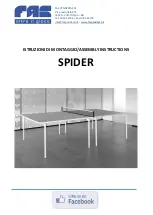
7
TRAMPOLINE SAFETY INFORMATION
In trampoline use, as in all active recreational sports,
participants can be injured. However, there are steps
that can be taken to reduce the risk of injury. In this
section, primary accident patterns are identified and
the responsibilities of supervisors and jumpers in acci-
dent prevention are described.
ACCIDENT CLASSIFICATION
Somersaults (flips):
Landing on your head or neck,
even in the middle of the trampoline bed, increases
the risk of a broken back or neck, which can result in
paralysis or death. Such events can occur when a
jumper makes an error trying to perform a forward or
backward somersault (flip). Do not perform somer-
saults (flips) on this backyard trampoline.
Multiple Jumpers:
More than one jumper on the
trampoline increases the chance of a jumper becom-
ing injured by losing control of his or her jump.
Jumpers may collide with one another, fall off the
trampoline, fall on or through the springs, or land
incorrectly on the bed. The lightest weight jumper is
the jumper most likely to be injured.
Mounting and Dismounting:
The trampoline bed is
several feet from ground level. Jumping off the tram-
poline to the ground or any other surface may result
in injury. Jumping onto the trampoline from a roof,
deck, or other object also represents a risk of injury.
Smaller children may need assistance getting onto or
down from the trampoline. Climb carefully onto and off
the trampoline. Do not step onto the springs or the
frame pad. Do not grasp the frame pad to pull your-
self onto the trampoline.
Striking the Frame or the Springs:
Injury may result
from encountering the frame or falling through the
springs while jumping or getting onto or off the tram-
poline. Stay in the center of the bed when jumping.
Make sure to keep the frame pad in place to cover
the frame. The frame pad is not designed nor intend-
ed to support the weight of the trampoline user. Do
not step or jump directly onto the frame pad.
Loss of Control:
Jumpers who lose control of their
jump may land on the bed incorrectly, land on the
frame or springs, or fall off the trampoline. A controlled
jump is one where the landing is in the same spot as
the takeoff. Before learning a more difficult maneuver,
the preceding one should be performed consistently
under control. Attempting a maneuver beyond present
skill levels increases the chance of loss of control. To
regain control and stop your jump, bend your knees
sharply when you land.
Alcohol or Drug Use:
The chance of injury increases
when a jumper has consumed alcohol or taken drugs.
These substances impair a person’s reaction time,
judgment, and physical coordination.
Encountering Objects:
Use of a trampoline while
other people, pets, or objects are underneath it will
increase the chance of injury. Jumping while holding
or having an object on the trampoline, particularly one
that is sharp or breakable, will increase the chance of
injury. Placing a trampoline too close to overhead
electrical wires, tree limbs, or other obstructions can
increase the chance of injury.
Poor Maintenance of the Trampoline: Jumpers may
be injured if a trampoline is used when it is in poor
condition. A torn bed, bent frame, broken spring, or
missing frame pad, for example, should be replaced
before anyone is allowed to jump. Inspect the trampo-
line before each use.
Weather Conditions : A wet trampoline bed is too
slippery for safe jumping. Gusty or high winds can
cause jumpers to lose control. To reduce the chance
of injury, use the trampoline only under appropriate
weather conditions.
Access: To prevent access to the trampoline by
unsupervised smaller children, the access ladder
should always be removed and stored in a secure
location when the trampoline is not in use.
Summary of Contents for Bazoongi
Page 2: ...2...








































